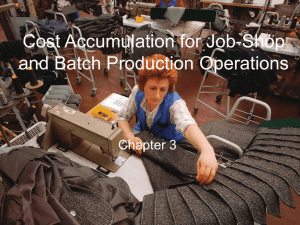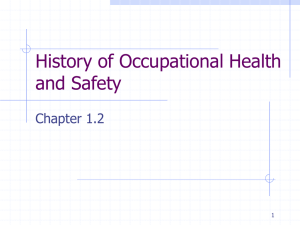COST ACCOUNTING- AN INTRODUCTION
advertisement
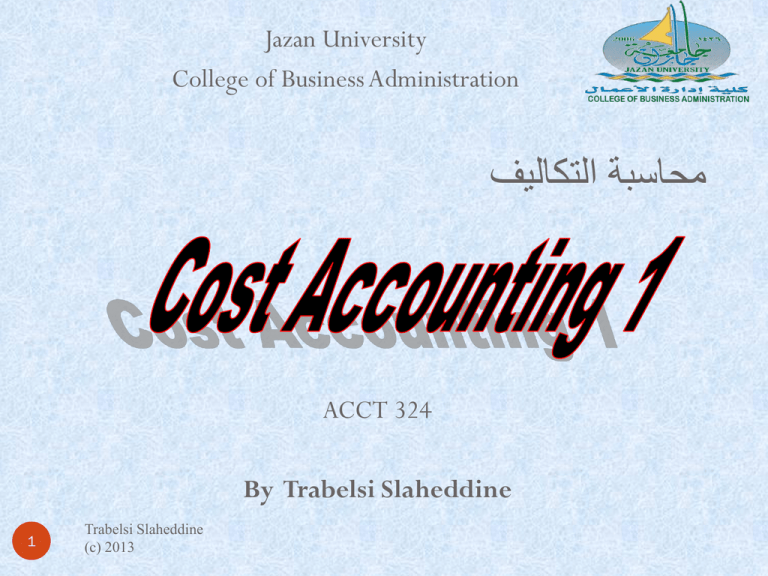
Jazan University College of Business Administration محاسبة التكاليف ACCT 324 By Trabelsi Slaheddine 1 Trabelsi Slaheddine (c) 2013 Contents Unit 1 : Introduction to Cost Accounting Unit 2 : Accounting for Material Unit 3: Machine per Hour Rate and preparation of Cost Sheet 2 Trabelsi Slaheddine (c) 2013 UNIT – 1: Introduction To Cost Accounting 1. Meaning of Cost and Cost Accounting 2. Objectives of Cost Accounting 3. Cost Terminology 4. Classification of Costs and Calculation of Various Cost. 3 5.Trabelsi 4.Slaheddine Home Assignment (c) 2013 1. MEANINGS COST - MEANING Cost means the amount of expenditure ( actual or notional) incurred on, or attributable to, a given thing. 4 Trabelsi Slaheddine (c) 2013 COST ACCOUNTING - MEANING Cost accounting is concerned with recording, classifying and summarizing costs for determination of costs of products or services, planning, controlling and reducing such costs and furnishing of information to management for decision making 5 Trabelsi Slaheddine (c) 2013 2. OBJECTIVES OF COST ACCOUNTING Ascertainment of costs Estimation of costs Cost control Cost reduction Determining selling price Facilitating preparation of financial and other statement Providing basis for operating policy 6 Trabelsi Slaheddine (c) 2013 3. COST TERMINOLOGY COST: Cost means the amount of expenditure incurred on a particular thing. COSTING: Costing means the process of ascertainment of costs. COST ACCOUNTING: The application of cost control methods and the ascertainment of the profitability of activities carried out or planned”. COST CONTROL: Cost control means the control of costs by management. Following are the aspects or stages of cost control. JOB COSTING: It helps in finding out the cost of production of every order and thus helps in ascertaining profit or loss made out on its execution. The management can judge the profitability of each job and decide its future courses of action. BATCH COSTING: Batch costing production is done in batches and each batch consists of a number of units, the determination of optimum Trabelsi Slaheddine 7 quantity (c) 2013to constitute an economical batch is all the more important. ELEMENTS OF COST Element of cost Materials Direct 8 Indirect Trabelsi Slaheddine (c) 2013 Labour Direct Expenses Indirect Direct Indirect MATERIAL: The substance from which the finished product is made is known as material. (a) DIRECT MATERIAL: is one which can be directly or easily identified in the product Eg: Timber in furniture, Cloth in dress, etc. (b) INDIRECT MATERIAL: one which cannot be easily identified in the product. 9 Trabelsi Slaheddine (c) 2013 EXAMPLES OF INDIRECT MATERIAL At factory level consumables, etc. – lubricants, oil, At office level – Printing & stationery, Brooms, Dusters, etc. At selling & dist. level – Packing materials, printing & stationery, etc. 10 Trabelsi Slaheddine (c) 2013 LABOUR: The human effort required to convert the materials into finished product is called labour. is one which can be conveniently identified or attributed wholly to a particular job, product or process. Eg:wages paid to carpenter, fees paid to tailor,etc. (a) DIRECT LABOUR: is one which cannot be conveniently identified or attributed wholly to a particular job, product or process. (b) INDIRECT LABOUR: 11 Trabelsi Slaheddine (c) 2013 EXAMPLES OF INDIRECT LABOUR At factory level – foremen’s salary, works manager’s salary, gate keeper’s salary,etc At office level – Accountant’s salary, GM’s salary, Manager’s salary, etc. At selling and dist.level – salesmen salaries, Logistics manager salary, etc. 12 Trabelsi Slaheddine (c) 2013 OTHER EXPENSES: are those expenses other than materials and labour. DIRECT EXPENSES: are those expenses which can be directly allocated to particular job, process or product. Eg : Excise duty, royalty, special hire charges,etc. INDIRECT EXPENSES: are those expenses which cannot be directly allocated to particular job, process or product. 13 Trabelsi Slaheddine (c) 2013 Examples of other expenses At factory level : factory rent, factory insurance, lighting, etc. At office level : office rent, office insurance, office lighting, etc. At sales & dist.level : advertising, show room expenses like rent, insurance, etc. 14 Trabelsi Slaheddine (c) 2013 BASIC COST SHEET DIRECT MATERIAL DIRECT LABOUR DIRECT EXPENSES ……………………………….. ……………………………… ………………………………… PRIME COST FACTORY OVERHEADS …………………………………. ………………………………….. FACTORY COST OFFICE OVERHEADS COST OF PRODUCTION SELL & DIST OVERHEADS COST OF SALES PROFIT SALES 15 Trabelsi Slaheddine (c) 2013 ……………………………… ………………………………. COST SHEET - ADVANCED OPENING STOCK OF RAW MATERIALS +PURCHASES +CARRIAGE INWARDS -CLOSING STOCK OF RAW MATERIALS VALUE OF MATERIALS CONSUMED +DIRECT WAGES +DIRECT EXPENSES PRIME COST +FACTORY OVERHEADS +OPENING STOCK OF WIP -CLOSING STOCK OF WIP FACTORY COST (CONT.) 16 Trabelsi Slaheddine (c) 2013 FACTORY COST +ADMINISTRATIVE OVERHEADS COST OF PRODUCTION +OPENING STOCK OF FINISHED GOODS -CLOSING STOCK OF FINISHED GOODS COST OF GOODS SOLD +SELL. & DIST. OVERHEADS COST OF SALES +PROFIT SALES 17 Trabelsi Slaheddine (c) 2013 4. COST CLASSIFICATION Classification On basis of : Nature Function Direct & indirect Variability Controllability Normality Financial accounting classification Time Planning and control Managerial decision making 18 Trabelsi Slaheddine (c) 2013 ON THE BASIS OF NATURE Materials Labor Expenses 19 Trabelsi Slaheddine (c) 2013 ON THE BASIS OF FUNCTION Manufacturing costs Commercial costs – ADM and S&D Costs ON THE BASIS OF DIRECT AND INDIRECT Direct costs Indirect costs 20 Trabelsi Slaheddine (c) 2013 ON THE BASIS OF VARIABILITY Fixed costs Variable costs Semi variable costs 21 Trabelsi Slaheddine (c) 2013 ON THE BASIS OF CONTROLLABILITY Controllable costs Uncontrollable costs ON THE BASIS OF NORMALITY 22 Normal costs Abnormal costs Trabelsi Slaheddine (c) 2013 ON THE BASIS OF FINANCIAL ACCOUNTS: Capital costs Revenue costs Deferred revenue costs 23 Trabelsi Slaheddine (c) 2013 ON THE BASIS OF TIME: Historical costs Pre determined costs ON THE BASIS OF PLANNING AND CONTROL: Budgeted costs Standard costs 24 Trabelsi Slaheddine (c) 2013 ON THE BASIS OF MANAGERIAL DECISION MAKING Marginal costs Out of pocket costs Sunk costs Imputed costs Opportunity costs Replacement costs Avoidable costs Unavoidable costs Relevant and irrelevant costs 25 Differential costs Trabelsi Slaheddine (c) 2013 TERMS IN COST ACCOUNTING 26 Cost unit Cost centre Cost estimation Cost ascertainment Cost allocation Cost apportionment Cost reduction Cost control Trabelsi Slaheddine (c) 2013 METHODS OF COSTING Job costing Contract costing Batch costing Process costing Unit costing Operating costing Operation costing Multiple costing 27 Trabelsi Slaheddine (c) 2013 TYPES OF COSTING 28 Uniform costing Marginal costing Standard costing Historical costing Direct costing Absorption costing Trabelsi Slaheddine (c) 2013 5. Home Assignment See Attached Home Assignment 1 and try to give answer to the following exercises: Exercise 1 Exercise 2 Exercise 3 29 Trabelsi Slaheddine (c) 2013 UNIT – 2: Accounting for Material Introduction FIFO LIFO AVCO 30 Trabelsi Slaheddine (c) 2013 Introduction As inventory is usually purchased at different rates (or manufactured at different costs) over an accounting period, there is a need to determine what cost needs to be assigned to inventory. For instance, if a company purchased inventory three times in a year at SAR 50, SAR 60 and SAR 70, what cost must be attributed to inventory at the year end? 31 Trabelsi Slaheddine (c) 2013 Inventory (stock) valuation A good estimate of closing stock is provided by three methods of stock valuation: First-In-First-Out (FIFO) Method Last-In-First-Out (LIFO) Method Average Cost (AVCO) Method 32 Trabelsi Slaheddine (c) 2013 First-In-First-Out (FIFO) Method In this method we assume that the first set of inventory received is the first to leave the warehouse. The resulting ending inventory will be valued at current prices. 33 Trabelsi Slaheddine (c) 2013 First-In-First-Out (FIFO) Method Example 34 Bike LTD purchased 10 bikes during January and sold 6 bikes, details of which are as follows: January 1 : Purchased 5 bikes @ $50 each January 5: Sold 2 bikes January 10 : Sold 1 bike January 15 : Purchased 5 bikes @ 70 each January Trabelsi Slaheddine 25 : Sold 3 bikes (c) 2013 With reference to FIFO method, complete the following table Date Purchase Units $/Units Issues $ Total Units Inventory $/Units $ Total Units $/Units $ Total Jan 1 Jan 5 Jan 10 Jan 15 Jan 15 Jan 25 1 35 Trabelsi Slaheddine (c) 2013 70 70 4 70 280 Last-In-First-Out (LIFO) Method In this method we assume that the last set of inventory received is the first to leave the warehouse. The resulting ending inventory will be valued at older prices. 36 Trabelsi Slaheddine (c) 2013 Example (LIFO) Same example Date Purchase Units Issues $/Units $ Total Units Inventory $/Units $ Total Units $/Units $ Total Jan 1 Jan 5 Jan 10 Jan 15 Jan 15 Jan 25 2 4 37 Trabelsi Slaheddine (c) 2013 70 140 240 Average Cost (AVCO) Method In this method, each time goods are purchased we calculate a new average cost of inventory. The average cost is calculated using the equation Average cost of inventory= Total value of goods on hand ÷ Quantity of goods on hand The resulting ending inventory will be valued at the last calculated average. 38 Trabelsi Slaheddine (c) 2013 Example: (same example) Date Purchase Units $/Units Issues $ Total Units $/Units Inventory $ Total Units $/Units $ Total Jan 1 Jan 5 Jan 10 Jan 15 Average Cost of Inventory Jan 25 39 Trabelsi Slaheddine (c) 2013 3 64.286 192.858 4 64.286 257.144 Exercise 1: Cindy Sheppard runs a candy shop. She enters into the following transactions during July: - July 1 Purchases 1,200 lollypops at $1 each - July 13 Purchases 500 lollypops at $1.20 each. - July 14 Sells 700 lollypops at $2 each. Calculate the value of inventory in the end of the month 40 Trabelsi Slaheddine (c) 2013 Exercise 2: 1 Mar opening balance 880 @ $9 2 Mar purchase 300 @ $6 4 Mar sell 400 6 Mar sell 600 10 Mar purchase 400 @ $8 15 Mar purchase 500 @ $5 22 Mar sell 900 27 Mar purchase 200 @ $2 28 Mar sell 100 30 Mar purchase 900 @ $3 31 Mar sell 700 What is the closing balance if this business uses the FIFO , LIFO, ACCO method? 41 Trabelsi Slaheddine (c) 2013 42 Trabelsi Slaheddine (c) 2013 Home Assignment See Attached Home Assignment 1 and try to give answer to the following exercises: Exercise 4 Exercise 5 Exercise 6 43 Trabelsi Slaheddine (c) 2013 UNIT – 3: Machine Hour Rate (MHR) 1. Definition 2. Concepts Related to MHR 3. Steps for computation of MHR 4. Components of Overheads 5. Procedures of Allocation of Overheads 6. Home Assignment 44 Trabelsi Slaheddine (c) 2013 Definition Machine Hour Rate (MHR) is a method of calculating production overhead absorption rate, where the number of hours the machines are expected to work is divided into the budgeted production overhead to give a rate per hour. 45 Trabelsi Slaheddine (c) 2013 Concepts Related to MHR - Economic Life (N):the period over which the equipment 46 can operate at an acceptable operating cost and productivity. Salvage Value (S): the price that equipment can be sold for at the time of its disposal. Fixed Costs: : Expensess which independant of the production Variable Cost: Cost which increase or decrease when the production increase or decrease. Overheads : indirect cost . Trabelsi Slaheddine (c) 2013 Exercise: For each cost specify if it is fixe or variable: Cost Depreciation Interest Taxes Rent Insurance Maintenance and Repair Fuel Power 47 Trabelsi Slaheddine (c) 2013 Fixed Variable Components of Overheads Overhead includes a large number of types of indirect costs Direct cost are identifiable to cost units, but overhead which are often considerable, cannot be related directly to cost units 48 Trabelsi Slaheddine (c) 2013 Stage method to allocate overhead to products Overheads are assigned to the cost centers such as department An allocation base is selected for allocating production centre expenses to products 49 Trabelsi Slaheddine (c) 2013 Procedures of overhead allocation to product Assign all factory overheads to cost centers Reallocate service-centre overheads to production cost centers Calculate separate overhead absorption rate for each cost centre Assign cost-centre overhead to products 50 Trabelsi Slaheddine (c) 2013 Assign all factory overhead to cost centers Cost allocation Cost apportionment 51 Trabelsi Slaheddine (c) 2013 Cost allocation Where a cost can be clearly identified with a cost center or cost unit, then it can be allocated to that cost center or cost unit 52 Trabelsi Slaheddine (c) 2013 Cost apportionment It is not possible to identify a discrete item of cost with a cost center and it is necessary to split a cost over several cost centers on some agreed basis 53 Trabelsi Slaheddine (c) 2013 Bases of apportionment Apportionment of indirect expenses to cost centers must be made on fair and reasonable bases Different types of expense require different bases according to their individual characteristics 54 Trabelsi Slaheddine (c) 2013 Base of apportionment Costs Area Rent and rates, heat and lighting, insurance of lighting Depreciation, machine insurance Machine value No. of employees 55 Example textbook P.183 Trabelsi Slaheddine (c) 2013 Wages of supervisors, canteen cost Reallocate service-centre overheads to production cost centers Service departments are not directly involved in production They only support service to other production departments in order to facilitate the production process Therefore, it is necessary to reallocate the service-centre overheads to production departments so that all production costs can be absorbed into production. Typical bases are listed as follows: 56 Trabelsi Slaheddine (c) 2013 Typical bases are listed as follows: Service departments Possible bases of apportionment Maintenance Maintenance labour hours, machine value Stores Value or weight of materials issued, number of requisitions No. of employees, no. of jobs inspection 57 Example textbook P.183 Trabelsi Slaheddine (c) 2013 Calculate separate overhead absorption rate for each cost centre To determine the overheads to be absorbed by a cost centre, it is necessary to establish an overhead absorption rate (OAR) Total overhead of cost centre OAR = Total number of units of absorption base applicable to cost centre 58 Trabelsi Slaheddine (c) 2013 An appropriate OAR should reflect the effort or time taken to produce the products Some commonly used absorption bases are listed as follows: 59 Direct labour hours It is frequently used in the labour intensive department because overheads assigned to this department are closely related to the direct labour hours worked Machine hours It is most appropriate for the appropriate for the machining department since most of the overheads are closely related to machine hours Trabelsi Slaheddine (c) 2013 60 Direct wages It is only suitable in the department where the uniform wage rate is applied Direct materials This method is not recommended unless the majority of overheads incurred in a department are related to materials instead of time Units of output This method is suitable only where all units produced in a period are identical in the production process and time. Therefore, this application is very rare Example textbook P.183 Trabelsi Slaheddine (c) 2013 Home Assignment See Attached Home Assignment 2 and try to give an answer to the only exercise provided. 61 Trabelsi Slaheddine (c) 2013
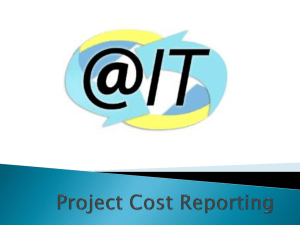
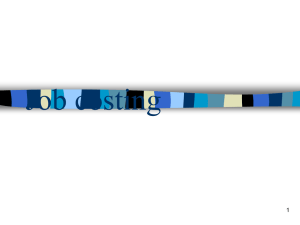

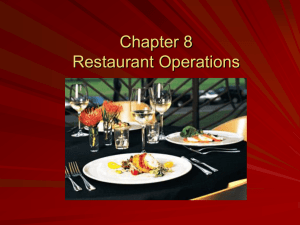

![Research Budget Seminar 2011 [MS PowerPoint Document, 1.9 MB]](http://s2.studylib.net/store/data/005266092_1-6f9260128baeee466f98ffcb88179aa1-300x300.png)
